Product growth tools help teams and PMs keep a finger on the pulse of what’s happening in a product. They make it easy to collect quantitative and qualitative data, so you and your teams always know what, why, and where the best growth opportunities are.
But it’s challenging to know how to build a product growth tech stack—one that provides deep, actionable insights—and how to use the tools to drive sustainable growth.
We've made a list of nine of the top product growth tools teams (including us at Contentsquare) use to drive sustainable product growth.
Summary
Product growth tools are software solutions that help teams collect user insights, plan feature updates, share data, and manage product roadmaps
Tools to understand user behavior:
Google Analytics
ChartMogul
Contentsquare
Tools to improve product experience:
Appcues
Optimizely
Google Optimize
Tools to prioritize the roadmap:
Tableau
Productboard
Trello
What are product growth tools?
Product growth tools are software that generate insights and establish processes to help you
Collect and manage qualitative and quantitative user insights
Shortlist and plan feature updates and initiatives that enhance growth
Display and share data with the product team and stakeholders and
Stay on top of product roadmap tasks and deadlines in the short and long term
Product and growth teams that don’t have access to the right tools, with the right data, are like artists without paint brushes—unable to do what they do best.
There are no one-size-fits-all product growth tools, nor is there just one tool that will do everything you need. Today, growth PMs need a range of tools to effectively perform their three core responsibilities:
Understand user behavior
Optimize the product for customer and business needs
Collaborate across teams to prioritize the product roadmap
Each of the tools we suggest below help product teams place users at the heart of their decision-making and take charge of product growth in a way that drives sustainable growth in customers and revenue.
As we dive into the key product growth tools, think about your unique organizational KPIs, product type, and user needs. This will help you determine which tools are best for your specific needs.
There’s no need to use every tool we cover. It’s more important to invest in a few purpose-built tools that are implemented properly and integrated tightly. Pick a few from each section, and you’ll have a well-rounded tech stack to support your product growth strategy.
Product growth tools to understand user behavior
Growth product management revolves around understanding users and customers. To do this, growth teams use tools that gather data on product analytics, product experience, and user research.
1. Google Analytics
Google Analytics (GA) is a free website analytics tool offered by Google that helps you collect, analyze, and report on website traffic data.
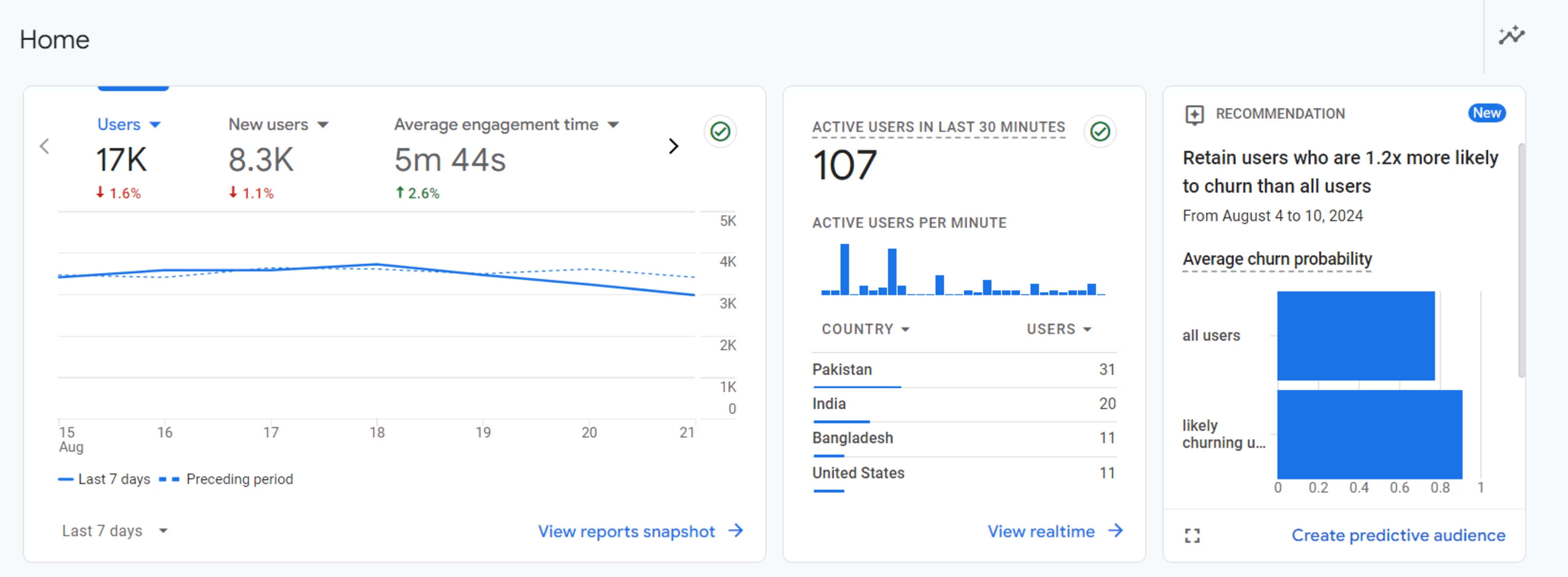
Google Analytics’s demo dashboard
How Google Analytics helps support growth
GA captures and helps you analyze quantitative data about what your customers actually do while on a certain page or website. This can uncover important realities about what resonates with your users—and what doesn’t.
Growth teams can use GA to
Gather valuable information about website traffic, top acquisition channels, and conversion paths
Track progress towards conversion goals and observe where potential customers drop off
Highlight paths and elements in the customer journey that can be conducive to growth
Track important growth metrics like conversion rate, churn, and retention rate
Use this data to calculate Customer Acquisition Cost (CAC) and Customer Lifetime Value (CLV)
For example, if you’re a SaaS business that wants to increase product adoption, you can use GA to generate product analytics data and understand how users interact with your product by visualizing their actions as funnel reports.
This lets you understand how different cohorts of users interact with your product, and identify the most engaged users—those who use the maximum number of product features.
Product teams can use these insights to prioritize features, while growth teams can identify friction points in the customer journey and improve product adoption and activation.
Pro tip: integrate Contentsquare with Google Analytics to complement GA’s traditional data with product experience insights.
Contentsquare is built to give added depth to the insights you get from GA: using them together, you can go deeper into where users click, how far they scroll, and where they’re engaging the most—to get a fuller picture of whether your site’s engaging users, and how they engage.
Use Google Analytics and Contentsquare together:
When you want to improve conversion rate
Before and after a website redesign
When you want to improve the customer experience
When you need buy-in from new management/clients/colleagues
When your business embraces digital transformation
![[Visual] Zoning and Heatmaps](http://images.ctfassets.net/gwbpo1m641r7/1fY6bBg1dnmmchw0aGq0u7/fbbc1440b4715d35ffdbf3b048eafd18/Zoning.png?w=3840&q=100&fit=fill&fm=avif)
A Contentsquare zoning heatmap in action
2. ChartMogul
ChartMogul is a freemium subscription and revenue analytics platform designed for SaaS companies. It’s designed to be free and simple to use, though there is a fee after your company hits $120K ARR.
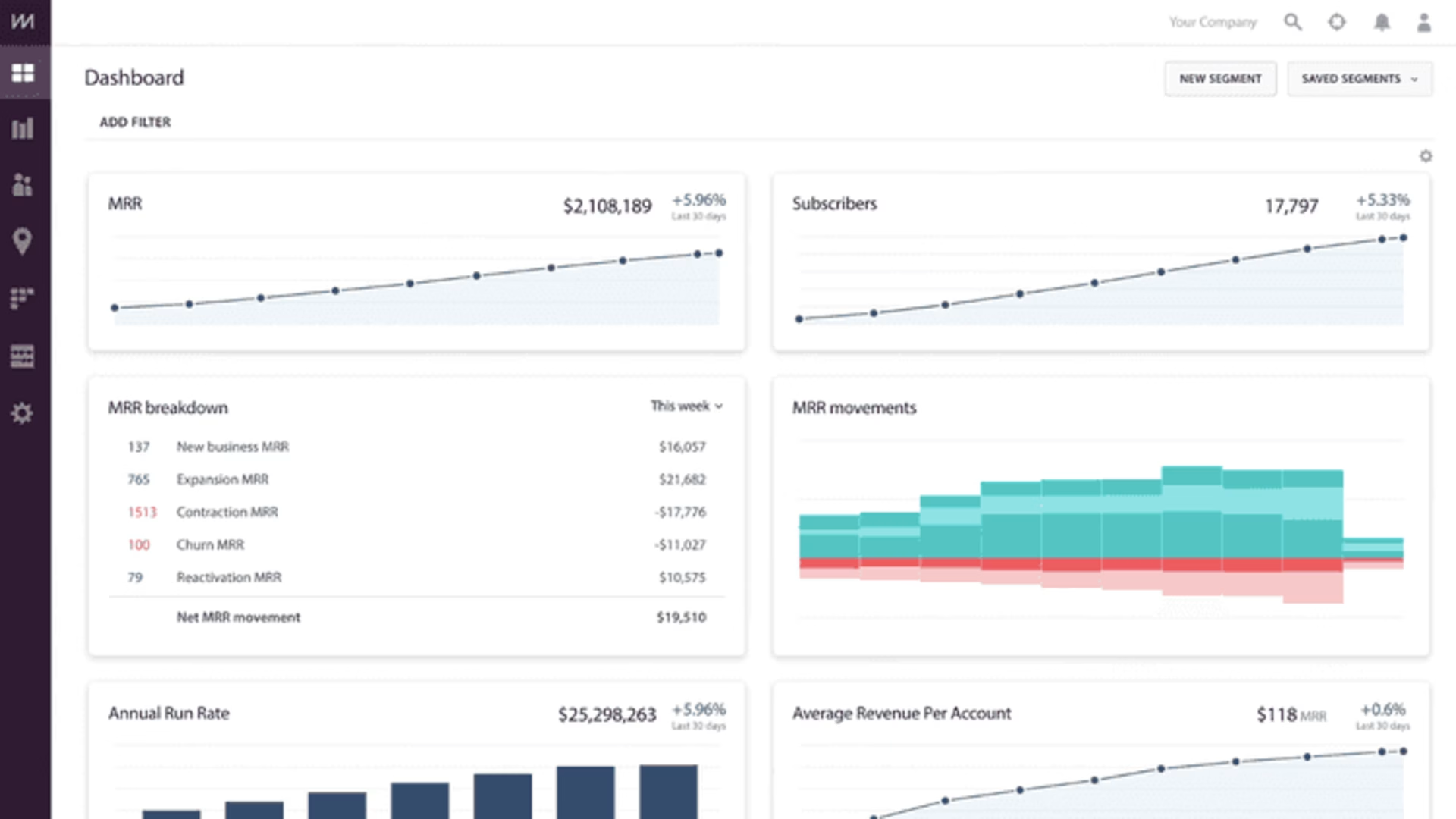
ChartMogul overview dashboard
How ChartMogul helps support growth
ChartMogul offers a wide variety of features to drive customer retention, identify cohorts for further investigation, and ensure sustainable product growth.
Growth teams use ChartMogul to
Automatically monitor growth metrics like product churn and expansion revenue
Track metrics that are most relevant to SaaS companies, like Monthly Recurring Revenue (MRR), Average Revenue per Account (ARPA), CAC, LTV, and trial-to-paid conversion rate
Segment data to find likely-to-convert user profiles and profitable pricing plans
Forecast cash flow and customer numbers based on current subscription data
3. Contentsquare
Contentsquare (that’s us, hi there! 👋) is an all-in-one experience intelligence platform that lets you access product analytics, digital experience monitoring and analytics, and user feedback.
Our tools help you observe how users behave on your website, ask them how they feel about your product, and access actionable insights into user sentiments and needs.
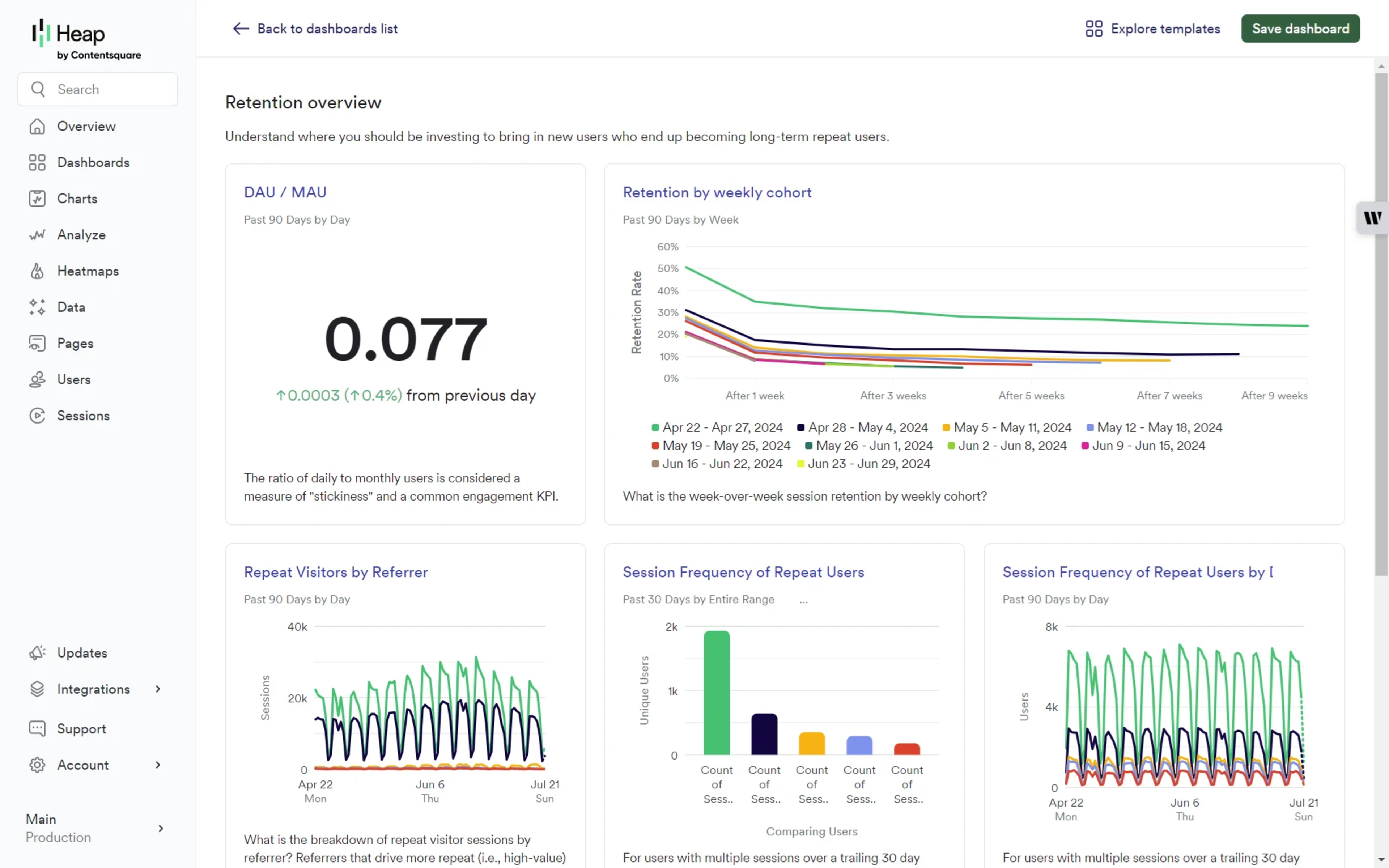
Contentsquare’s Product Analytics dashboard
How Contentsquare helps support growth
As a growth product manager, you spend a lot of time trying to read your customers’ minds and unearth what the experience of using your product is like for them. With experience analytics tools like Contentsquare, you can get insight into user behavior like never before.
Contentsquare is an indispensable product growth tool for teams that want to gain access to (and make sense of) both qualitative and quantitative data. In practical terms, it means you can look at a number (like drop-off rates) to see the ‘what’, and turn to Contentsquare to dig deeper and understand the ‘how’ and ‘why’.
Say Contentsquare’s Customer Journey Analysis reports a high drop-off rate on your product pages, and management is convinced that people are leaving because the content is too long. Using Contentsquare, you can use data to prove or disprove this assumption, demonstrate the way forward, and bring everybody on board with the decision.
For example, a well-placed survey or feedback widget using our Voice of Customer tool could let your users tell you they want more information, rather than less. You can then make a business case to revise the content and provide fuller descriptions; you’ll also likely get the green light to test the new descriptions and see what effect they have on the drop-off rate.
Contentsquare is designed to help you spot common areas of friction in the user experience, get ideas for improvements, and measure if your fixes are working (and why).
Growth teams use Contentsquare to
Identify user behavior that correlates with desired product outcomes, like free trial-to-paid conversion
Spot problems, bugs, and user pain points with heatmaps, and experiment with fixes that address them
Optimize products to increase growth metrics like customer retention and revenue
Measure the adoption of new features by analyzing session replays—real-time renderings of users on your site
Target users with surveys to get product feedback from a specific cohort
Dig deeper into the product experience and collect real-time user feedback with feedback widgets
Collect data points and feedback about how people really use the product, and add it to the reports they share with stakeholders, colleagues, and clients
Combine Contentsquare insights with other product growth tools to see what’s behind the numbers
Make informed product decisions for sustainable growth
Product growth tools to improve the product experience
After combining user research with business insights, you can move on to the next step for sustainable product growth: identifying growth opportunities and creating hypotheses for optimization experiments.
Growth PMs use product experimentation tools to A/B test changes and incrementally roll out product updates, in their continued search for optimization and customer delight.
4. Appcues
Appcues is a user onboarding and product adoption tool designed for building in-app product tours and onboarding flows. From user onboarding to adoption and retention, Appcues helps product teams build personalized customer experiences.
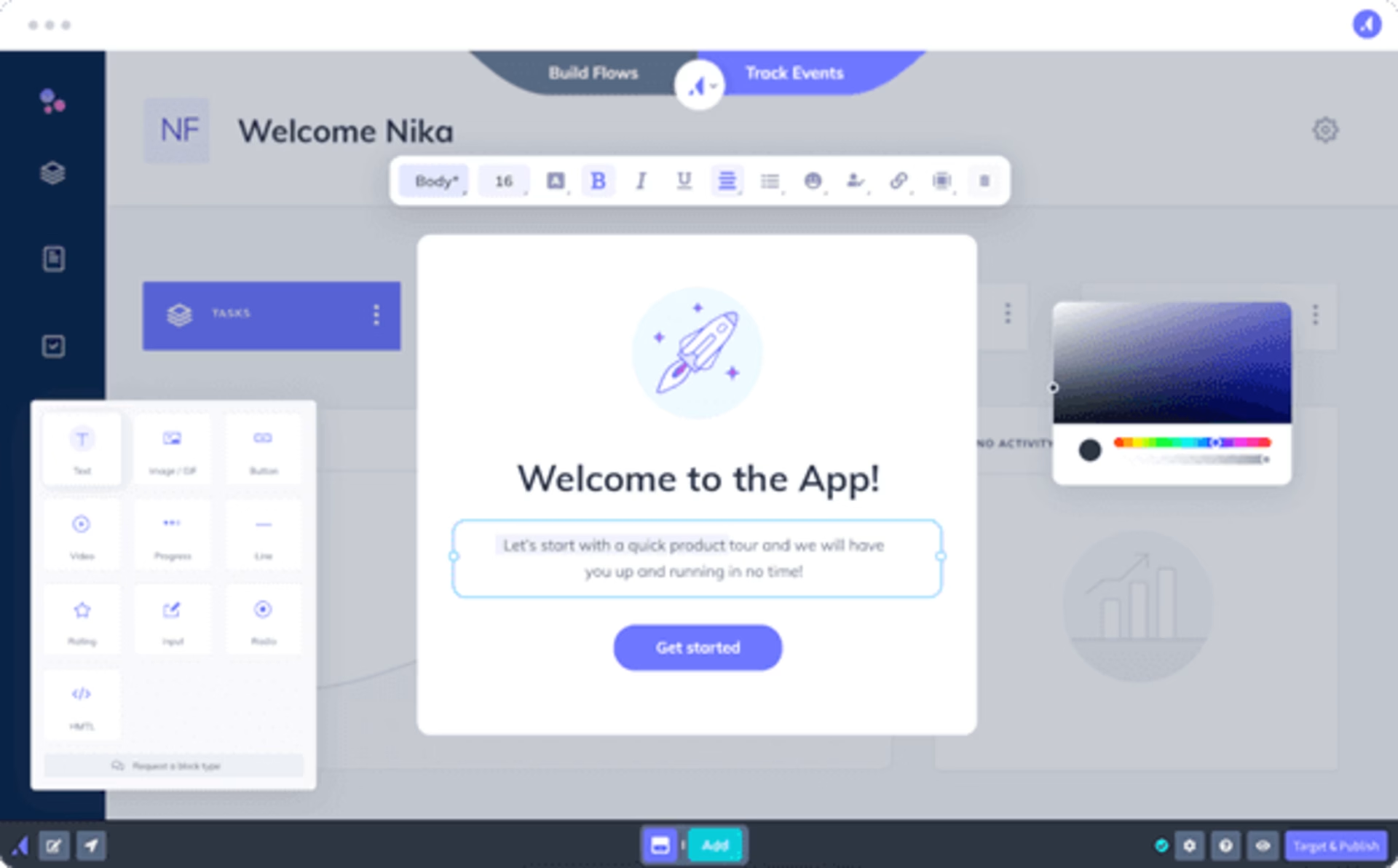
Appcues dashboard
How Appcues helps support growth
On your journey to sustainable product growth, you can use Appcues to improve user retention, feature adoption, and drive customer engagement with zero coding skills. This includes
Creating interactive in-app walkthroughs for new users without writing a single line of code
Designing customer onboarding flows to reduce Time-To-Value (TTV) for new users
Monitoring the effectiveness of your onboarding efforts and measure product adoption
Sending users notifications with new or relevant features to increase adoption
Collecting user feedback and a Net Promoter Score® (NPS) to monitor user sentiment
Running hyper-targeted in-app surveys for analyzing and collecting customer feedback on the fly
Sharing your workflows with the rest of your product team to get their feedback, and quickly implement any changes
5. Optimizely
Optimizely is an experimentation platform that provides easy A/B testing on websites. The tool allows for experimenting with various web features and achieving validation for CRO efforts, providing minimized risk and a better understanding of customer behavior.

Optimizely experiments dashboard
How Optimizely helps support growth
As a digital experience platform, Optimizely includes multiple tools for web, server-side, email, and B2B commerce experimentation.
Their Web Experimentation tool lets growth teams run A/B and multivariate tests and personalization campaigns to improve conversion rates and the user experience.
For example, you can test your hypotheses about various web design aspects—like navigation bars, color schemes, CTA placement, or search bars—to build better websites and products that resonate with and engage your audience.
Optimizely lets you
Conduct website experiments and gather data about your audience to leverage for key product optimizations
Test UI changes to see their impact on user behavior, and correlate results with desired product outcomes like revenue and retention
Use its visual editor for an easily customizable product experience with no-code edits
Add custom CSS and Javascript to your site to improve the customers’ experience when and where they need it
The Contentsquare x Optimizely integration lets you combine A/B testings and experience analytics.
Eyewear brand used Contentsquare and Optimizely to recover $15M in revenue by optimizing their homepage by pairing A/B testing and Zone-Based Heatmaps.
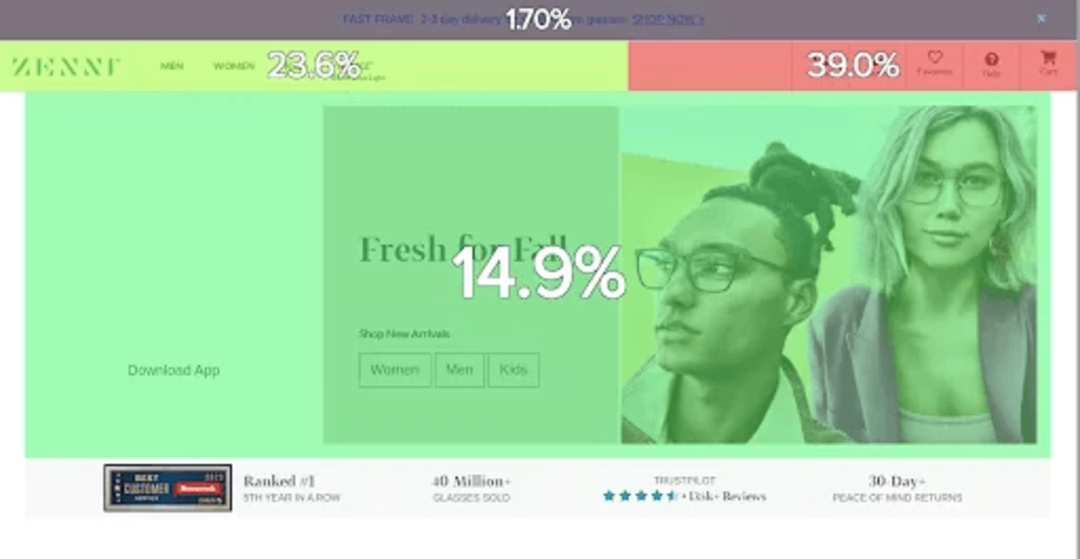
"
Using Contentsquare and Optimizely together was key to our data-informed optimization strategy. Seeing where we needed to make changes based on user behavior with Contentsquare and then testing those changes using Optimizely made upgrading our homepage experience much faster and more efficient."
David Ting
CTO at Zenni Optical
6. Google Optimize
Google Optimize is a freemium experimentation platform that offers A/B, multivariate, and redirect testing and optimization tools for usability testing and optimization.
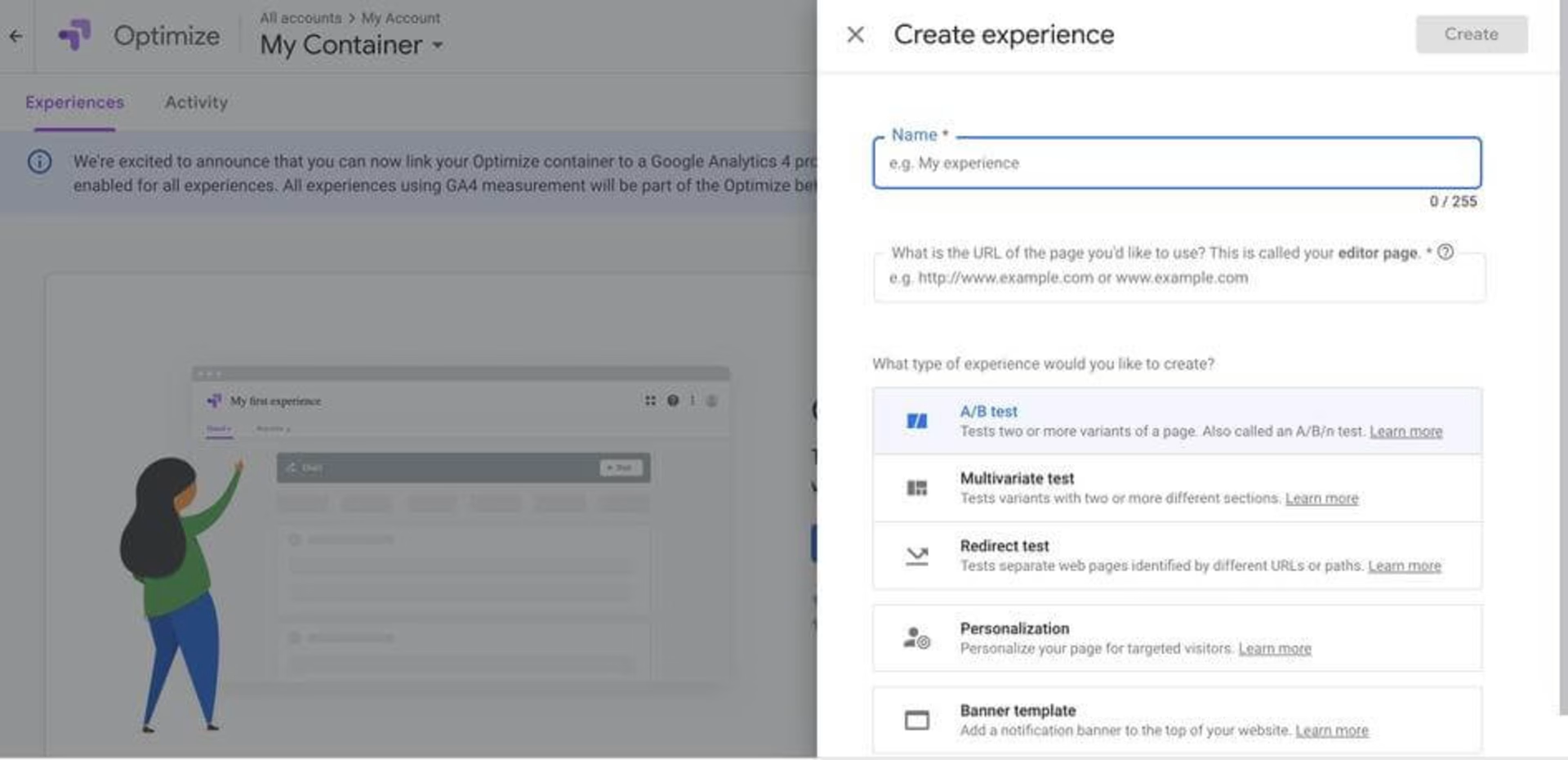
Google Optimize dashboard
How Google Optimize helps support growth
Growth teams can run tests on different product or feature variants to compare performance and improve goal conversion.
Here’s how you can take advantage of Google Optimize’s features and integrations to achieve growth:
A/B test variations of your online assets to learn what works best for your audience, and optimize product adoption and upsell
Creating test variations and previewing experiments without coding knowledge using the Google Optimize Chrome extension
Use Contentsquare’s Customer Journey Analysis to find points in the user journey with steep drop-offs and create A/B tests with Google Optimize to reduce the drop-off rate
Connect Google Optimize to Google Analytics, Google Ads, or Firebase to optimize experiences across multiple channels—i.e. your website, paid advertising campaigns, and mobile app
Pro tip: set up and combine metrics from Contentsquare and Google Optimize to add qualitative user data to your experiments.
Get more from your Google Optimize tests by using Contentsquare to collect qualitative session replay and survey data during experiments.
This gives you clearer insight into why a winning variant is successful, and how you can replicate it in the future, at scale.
Product growth tools to prioritize the product roadmap
Product prioritization and management tools help growth PMs plan, manage, and prioritize the product roadmap, and communicate strategy and outcomes across the organization.
7. Tableau
Tableau is Salesforce’s enterprise business intelligence and analytics platform for visualizing and analyzing data.
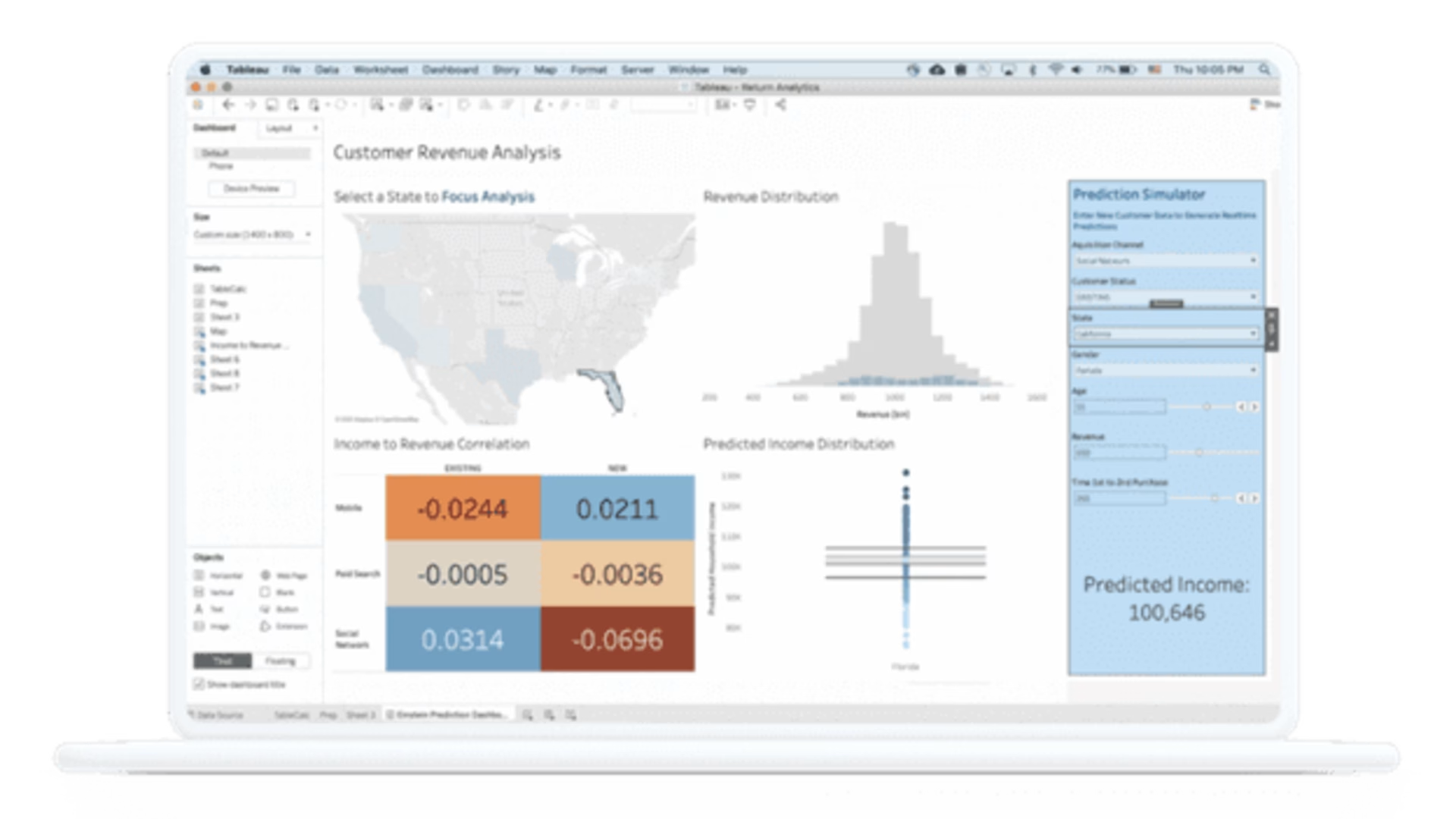
Tableau dashboard
How Tableau helps support growth
Tableau lets you visualize data from tens of different sources like product analytics software, CRM, user surveys, sales and customer success reports, and more.
Building a product roadmap involves input and feedback from many sources and stakeholders. A task with this amplitude requires a product growth tool that can collect and combine data into a single, easy-to-use dashboard.
Using Tableau, growth PMs can create dashboards to monitor and bring together a range of data—from customer support, product, marketing, and sales teams—all in the same place. They can
Import and connect product data from multiple teams and departments
Track the performance of ongoing digital marketing campaigns
Build and share interactive charts and graphs to spot trends in the customer experience
Analyze the impact of changes introduced in pricing plans
Generate statistical analyses and forecast summaries with the Einstein AI predictive analytics and recommendations module
Visualize and share key product insights company-wide
Tableau is far from being just a visualization tool. This product growth software actually sees and analyzes the data it handles, helping growth PMs place users at the heart of their decision-making.
Think: PMs can use Tableau to learn how likely the introduction of a new product feature would impact retention rates, or how the Customer Effort Score will improve year-over-year due to a freshly-redesigned interface.
Tableau ultimately empowers growth PMs—even those with no tech background—to engage in their own predictive analysis using scenario planning, simulations, or other data science techniques.
8. Productboard
Productboard is a product management platform that consolidates customer feedback from different sources in one place, to make it easier to filter and understand. This can include customer service tools, internal chat apps, sales conversations, and customer-facing chat apps.
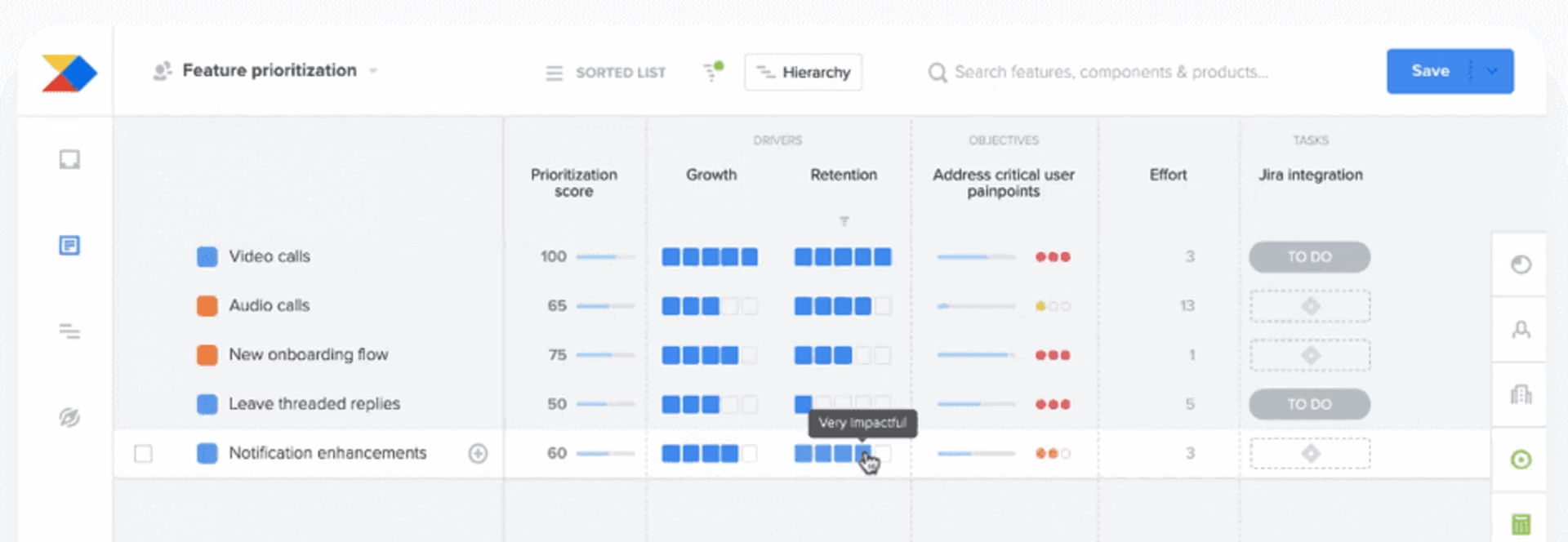
Productboard dashboard
How Productboard helps support growth
Productboard helps growth teams manage product insights, prioritize features, and build roadmaps—all in one place.
This product growth tool has its own prioritization system, which lets you quantify the value and effort of each feature and create an overall prioritization score. Productboard also generates a prioritization matrix so you can visualize the trade-off between a feature’s value and effort against each of your business objectives.
Here’s how growth PMs can use Productboard features to enhance growth:
Prioritization: prioritize feature requests based on the number and type of customers (free, paid, premium) who request it. This helps you align your product roadmap with customer expectations.
Tags: add relevant tags to customer feedback for easy access. Customer feedback is most useful when your team can find, analyze, and integrate it into their workflow with ease.
Roadmaps: use customer feedback to create detailed product roadmaps. This will give your team a big-picture overview of how a product will get from its current state to its future destination.
9. Trello
Trello is a project management tool used to organize ideas, to-do items, and tasks in a simple format. The software was designed by Atlassian, the same team behind Jira.

An example of Hotjar by Contentsquare’s public product roadmap, built in Trello
How Trello helps support growth
Using a web app like Trello allows growth teams to track and share various items on the product roadmap with relevant team members. From startup to enterprise level companies, this setup is especially useful for agile teams that need to keep everyone up-to-date within a given sprint.
Growth PMs can group relevant product optimization items into easy-to-view Boards—like ‘Features in Progress’—and then attach individual Cards, such as ‘Product Data Sheet’ or ‘Case Studies'. These cards can easily be dragged and dropped under different Boards—say, from ‘In Progress’ to ‘Under Review'.
Put product growth tools into action
The best product growth tools align your company around shared product goals, help growth PMs manage and prioritize the product roadmap, and get customers excited about a product’s direction.
No matter which of these tools you choose to add to your product growth tech stack, Contentsquare provides customer-centric insights that help you and your team balance impact, user needs, and profitability.
FAQs about product growth tools
Which tools can help you with product growth?
You can drive product growth by using tools like
ChartMogul: to track metrics like MRR and churn
Contentsquare: to see where users get stuck, learn what’s motivating them, and get in-the-moment customer feedback
Appcues: to build personalized customer experiences
Productboard: to combine customer data from multiple sources
Tableau: to build and share interactive charts and graphs with your team
Why do growth PMs need to use product growth software?
By combining data from multiple product growth tools, growth PMs can get a fuller picture of what’s happening in a product and make data-driven optimization decisions.
Product teams can use these tools to manage, analyze, and share product data, placing users at the heart of their decision-making in a way that drives sustainable growth in customers and revenue.
What are some common features of product growth tools?
Key features to look for in product growth tools:
Ease of use
Access to quantitative and qualitative product insights
Ability to access usage reports and data without code
Product roadmap planning
API integrations with other product growth tools
Segmentation of product usage data
Ability to collect customer feedback
Collaboration across teams
Net Promoter®, NPS®, NPS Prism®, and the NPS-related emoticons are registered trademarks of Bain & Company, Inc., NICE Systems, Inc., and Fred Reichheld. Net Promoter ScoreSM and Net Promoter SystemSM are service marks of Bain & Company, Inc., NICE Systems, Inc., and Fred Reichheld.
